1934 - present ~Shushan Airport (now New Orleans Lakefront Airport)


Under the direction of Governor Huey P. Long stalwart Abe Shushan, the Orleans Levee Board built a state-of-the-art airport at a cost of $3 million on a filled-in area of Lake Pontchartrain in New Orleans. It was the FIRST COMBINED LAND AND SEAPLANE AIR TERMINAL IN THE WORLD. The new facility, called Shushan Airport, hosted the Pan-American Air Races as part of its opening ceremonies in February 1934. Just before the races started, officials barred women from competing, a controversial move. On the first day of contests, a crash claimed the life of a stunt pilot. A parachute jumper and a pilot died three days later after the jumper's chute caught on the tail of the plane. These races demonstrated once again the risks of air stunts. Jimmie Wedell entered the races and flew the '45' to a new 100-kilometer world speed record of 266 miles per hour. The '45' was expected to be his most spectacular speed ship, the basis for his successful bid to the United States Army for a pursuit-plane design.
Source: State Museum online exhibit--Louisiana Aviation since 1910
http://lsm.crt.state.la.us/museum/aviation/wedell3.htm
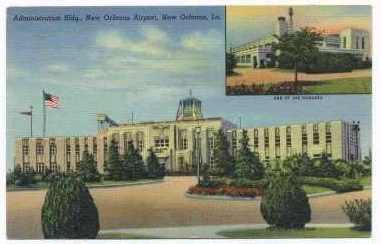
Linen Era Postcard of the Administration Bldg.
PUBLISHER Genuine Curteich, Chicago
CARD SIZE: 3-1/2? x 5-1/2?
'C.T. Art Colortone'
Reads on back:
Combined land and seaplane base located on a peninsula on Lake Pontchartrain.
This dual picture card is part of the 'New Orleans - America's Most Interesting
City' series.

Airliner at Shushan Airport
Source: http://store.corbis.com/search/about_pic.asp?imageID=11432028&alphaimageid=LW002476&navid=decorate/prints/

Administration Building postcard. Date unknown.
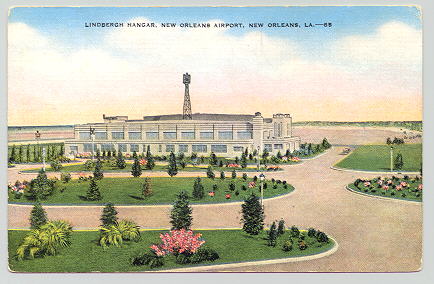
Lindberg Hanger
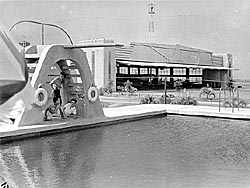
Shushan Airport -
view of the swimming pool built by WPA with hanger in back which had work done
by WPA.
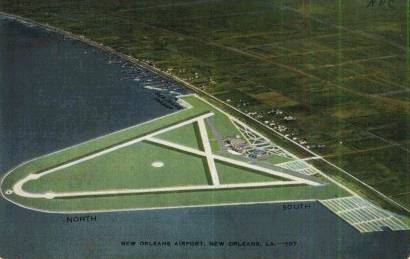
Postcard shows Shushan (now 'Lakefront') Airport--notice the camps to the
left of the airport.
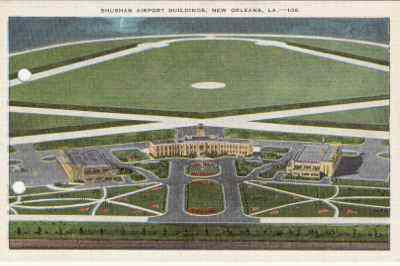
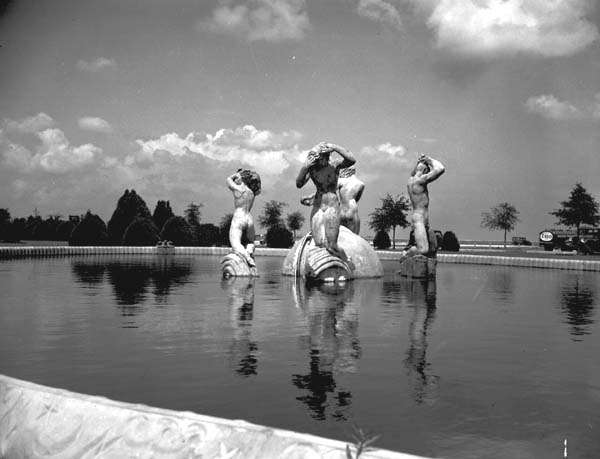
Fountain of the Four Winds--Enrique Alvarez. Circa 1938
From Gambit Weekly--Blake Pontchartrain:
HEY BLAKE,
Recently, a group of us senior citizens dined at Shushan Airport. One of our number said she remembers that all of the screws used in the construction of the building had heads with slots in the shape of the letter S. Special screwdrivers had to be designed to accommodate this peculiarity. Can you throw any light on this subject?
Also please tell us who was Shushan? Tell us what you know or can find out about this New Orleans landmark.
SUZANNE OLIVIER
DEAR SUZANNE,
While the story about the special
screws is fun to tell, I'm afraid it's just that -- a story. However, the man
for whom the airport was named is one of New Orleans' real characters.
Abraham Lazar Shushan, politician and businessman, was President of the Orleans Levee Board during the years when the airport was built, 1929-1933. He was given much credit for overcoming many obstacles during the Depression in order to
create a unique and modern airport designed by the architectural firm of Weiss, Dreyfous & Seiferth. Shushan supported and was supported by Governor and later U. S. Sen. Huey P. Long.
The land on which it was built is an artificial peninsula made from land reclaimed from Lake Pontchartrain. When the airport, at a cost of about $3 million, opened on Feb. 9, 1934, it was considered one of the finest in the country at that time. Shushan's flood protection and aviation achievements were praised as major
accomplishments.
However, Shushan was indicted in 1935 for income-tax evasion on rebates to the Long administration by land-fill contractors. After a sensational trial, he was acquitted, but resigned from the Levee Board in the same year. Then in 1939 he was indicted again -- for using mails to defraud -- during the 'Louisiana Scandals' that shocked the nation. Nearly 150 people, including Gov. Richard Leche and Louisiana State University President James Smith, and 40 organizations and business firms were indicted on charges of use of WPA labor, theft of material, income-tax evasion, mail fraud, kick backs, and conspiracy to defraud. Leche and Smith, among others, were imprisoned and others were fined. Although he escaped jail, Abe Shushan was
one of those convicted after the long, complicated trial. He was pardoned by President Truman in February 1947.
After it was all over in 1939, the Orleans Levee Board recommended a name change for the municipal airport. But it was not an easy task because Shushan had immortalized himself by having his name on just about everything at the airport. He had often boasted that it would take $50,000 to $100,000 to take the Shushan tokens off the place. This is probably how the story of the S screws came about. Whenever Abe saw a space that was too small for his name, he used his initial. There were S's everywhere: in the lavatories, on the doors, in letters in the tiles in
the floors. He had S's on the sides of the buildings, in the pavement, and even in the pattern of the flower gardens outside.
One board member shook his head and said, 'We haven't got the kind of money it would take to get Abe off everything.' So they chipped away at all the traces of Abe as finances would allow. By the late 1940s, they were still trying to rid the airport of
signs of Abe. A few folks suggested that the airport be demolished and a new one built. Someone with a sense of humor suggested that they just leave the S's and rename the airport after a historical figure with a good reputation.
The airport soon became too small to accommodate increasing traffic and larger planes, so in 1945 Moisant (now New Orleans) International Airport was constructed and named for John B. Moisant, a famous pioneer aviator who lost his life nearby on Dec. 31, 1910.
As for Abe Shushan,
who had been born in Reserve on Jan. 12, 1894, he died on Nov. 3, 1966. Rabbi
Leo Bergman of Touro Synagogue officiated at the service, and burial was in
Chevra Thilim Cemetery.
Source: href='http://www.bestofneworleans.com/gw/feat-blak.html'>http://www.bestofneworleans.com/gw/feat-blak.html










